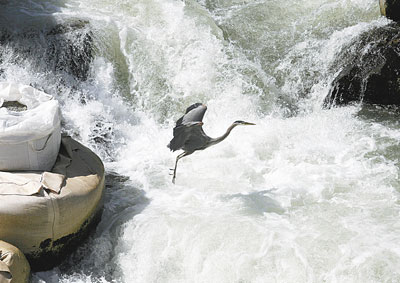|
Great blue heron both gawky and stately
 |
Tim Bullard/Daily Courier
A great blue heron swoops across the Rogue River. |
Great blue herons are plentiful in the Rogue Valley, but I didn’t know much about them until I talked with two experts. In this question-and-answer, they share some interesting tidbits about a bird that I’ve always found both majestically beautiful and somewhat awkward-looking. Here’s a photo gallery of some local Rogue Valley birds. o o o oBy Zach Urness of the Daily CourierThe great blue heron swooped down through a creamy layer of mist above the Rogue River canyon, drifted on the breeze and landed on a large rock about 25 yards from my kayak.The bird adjusted himself with a shimmy and used a long S-curved neck to preen its pale-blue feathers with a yellowish beak. I've never been much for bird-watching, but there's something special about blue herons that always catches my eye. They seem both goofy and serious, both awkward and graceful, and have a sort of exotic appearance despite being found everywhere in the Rogue Valley. I love the way they stand on a rock in the middle of the river — that long neck supporting a mohawked head — and give you a look that suggests you ought to be paying toll in order to pass. People assume the best part of my job is writing about fishing, kayaking and mountain climbing. But it's not. The best part of my job is observing a bird that lands near my kayak in the rain, and then talking with people far smarter than myself about where the bird lays eggs and calls home. I did just that with Lee Webb and Dennis Vroman, a pair of local bird experts retired from the Forest Service. The former was a wildlife biologist with the Rogue River-Siskiyou National Forest, while the latter co-authored the book "Guide to the Birds of the Rogue Valley" (2003) and teaches bird identification classes at the Siskiyou Field Institute. From these two, I learned that great blue herons nest in colonies (rookeries) to lay eggs, but generally lead solitary lives. They usually live around 10 years, dine on everything from fish to earthworms, and will attempt to stab you in the eye with their knife-like beak should you attempt to mess with them. They've also retained healthy numbers in Southern Oregon, despite behavior that will occasionally earn the wrath of local anglers. "Once near Grave Creek bridge, I watched a great blue heron slowly meander in the direction of a fellow fishing nearby," Vroman said. "When the fisherman moved further away, the heron very quickly grabbed one of his fish and took off. "Who said there's no such thing as a free lunch?" Zach Urness: "Where are you most likely to see great blue herons in the Rogue Valley?" Lee Webb: "They forage and hunt pretty much anywhere in our area along open, relatively quiet water. They also frequent most farm fields, along Upper River Road for example. We have a good mixture of open water and forest along our major rivers and lakes in this area, which is good habitat." Dennis Vroman: "Winter does find them concentrated in fields and pastures in the lowlands surrounding the river. I've seen upward of 30 birds gathered in some pastures in the winter. Winter and nesting time are about the only times they are seen in large numbers together. Otherwise they tend to be solitary." ZU: "Is there a specialized type of great blue heron native to this region? Are the ones you see in this area different from others across the country?" LW: "There's only one type of GBH. They range over most of North and Central America, the Caribbean and even the Galapagos Islands. If you see a GBH in North Carolina, it's the same species. There are six North American subspecies and three in Oregon. Ardea Herodias Hyperonca is found in western Oregon. All look quite similar." ZU: "What do they eat?" LW: "Mostly fish, but also whatever else might be available, from aquatic insects, amphibians, reptiles, small mammals and small birds." DV: "They feed pretty heavily on earthworms in the Rogue Valley in winter. I've watched them — along with great egrets — eating them in the wet pastures during winter." ZU: "How old do most get?" LW: "They first breed in their second spring. I found a record for a banded bird which lived to 22 years, but perhaps 10 years might be a good average for a chick that lives through the 'stupid' youth years." ZU: "Do they have any natural predators?" LW: "Eggs and young could be taken by ravens, hawks and raccoons. Because they're so large, adult GBH don't have many predators. Great-horned owls and eagles take a few." DV: "Their long, sharply pointed bill is like a dagger. They go for the eyes, so you don't want to mess with them unless you know what you're doing." ZU: "Do they nest in the Rogue River area?" LW: "You can see GBH along the Rogue River in any month. They nest in colonies (rookeries) with three to six eggs per next. A rookery is located across from Whitehorse Park. A rookery along the Applegate River upstream from the Murphy bridge had many nests in multiple trees a few years ago." DV: "There are numerous scattered rookeries (some with a small number of nests) along the Josephine County portion of the Rogue River, near Morrison's Lodge and below Galice as examples." ZU: "Do they stay year-round or migrate elsewhere?" LW: "Some stay year-round in a general area, and some make seasonal migration. In the more northern part of their range, many travel north in the breeding season and south in the winter season." o o o For more pictures of great blue herons, click here.
| 




